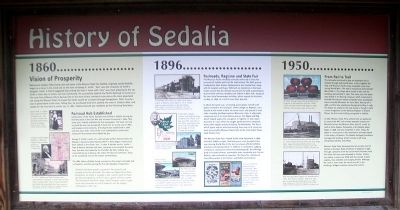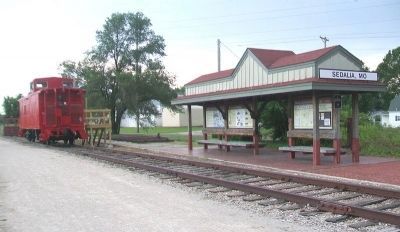History of Sedalia
1860...
Vision of Prosperity
Welcome to Sedalia, Pettis County seat and home of the Missouri State Fair. Sedalia, originally named Sedville, began as a vision in the mind and on the farm of George R. Smith. "Sed" was the nickname of Smith's daughter, Sarah. A friend suggested that ending the town's name with "alia" was more pleasing to the ear. Smith's vision was to build a rail hub community. He successfully lobbied the Pacific Railroad to construct a line west from Jefferson City to Kansas City on the more direct, overland route versus the more populated one along the Missouri River. He hoped the tracks would be surveyed through Georgetown, Pettis County's seat of government at the time. Failing this, he purchased land here, platted the town in October 1860, and waited for the first train to arrive, Jan. 17, 1861. Sedalia claimed 300 residents by the following December.
Railroad Hub Established
Construction of the Pacific Railroad was halted at Sedalia during the first few years of the Civil War, but resumed in earnest in 1864. That same year, Sedalia published its first newspaper. The town not only survived the war, but prospered. It took over as county seat in 1865 and boasted 1,000 residents. A brickyard was established in 1866, and two years later, some of the more substantially constructed
George R. Smith's vision of a rail hub was further realized when the Missouri, Kansas & Texas Railway (MKT or Katy) began construction from Sedalia to Fort Scott, Kan., in 1870. A decade earlier, Smith's Tebo & Neosho Railroad had been chartered to accomplish the same task, but was interrupted by the Civil War. By 1873, Sedalia was connected by rail to Kansas, the Indian Territory and Denison, Texas, to the southwest, and to the eastern United States.
The 1882 History of Pettis County summarizes the impact railroads had on Sedalia's economy during the first two decades of operation.
"Sedalia has been greatly assisted in her growth and prosperity by her railroads. She does not depend on them altogether, for there is enough in the country itself to make the place proserous, still it is now a great railroad center. The enormous machine shops, which employ such a large force and consume so much material, are the largest institutions in the city."
[Photo captions read]
Sarah "Sed" E. Cotton, after whom her father named the city, was an active citizen who donated several tracts of land to Sedalia.
Photo courtesy of Pettis County Historical Society.
George R. Smith platted Sedalia in 1860 and helped bring railroads to the city.
Photo courtesy of Charles Wise.
By
Photo courtesy of Pettis County Historical Society. Map used by permission, State Historical Society of Missouri, Columbia.
1896...
Railroads, Ragtime and State Fair
The Missouri Pacific and Katy railroads continued to drive the economy of Sedalia well into the 20th century. The MKT general headquarters (later division headquarters) was located here, along with its hospital and shops. With such an investment in the town, it was natural that the railroad would wish to build a grand depot. A prominent architect, Bradford Lee Gilbert of New York, designed the two-story Romanesque building, which opened for business on May 10, 1896, at a cost of more than $40,000.
In about the same year, a traveling piano player named Scott Joplin enrolled in the George R. Smith College for Negroes, once located a mile north of here. He wrote music and played in local clubs, including the Maple Leaf and Black 400 clubs. In 1897, Joplin composed one of his most famous pieces, the Maple Leaf Rag, which helped spawn the new genre of ragtime. In 1901, Joplin moved to St. Louis where he taught, performed and composed many other ragtime pieces including The Entertainer. The flat in which
Joplin and his wife lived during their time in St. Louis has been preserved by Missouri State Parks as the Scott Joplin House State Historic Site.The Missouri State Fair, created by the state legislature in 1899, moved to Sedalia in 1901. Held every year since except for two years during World War II, the fair has always offered exhibits, activities and entertainment. In addition to competitive judging of livestock, sewing and canned and baked goods, the offerings grew to include concerts, automobile races, vaudeville acts, hot-air balloon rides and political speeches. The State Fair introduced many Missourians to the tractor, automobile and airplane.
[Photo captions read]
A passenger train takes on water for its steam engine at Sedalia's Katy depot in 1913. Diesel engines replaced steam in the late 1940s.
Photo courtesy of M. Fred Lyon Collection, 1870-1991, Western Historical Manuscript Collection-Columbia, Mo.
Scott Joplin, Sedalia resident and Ragtime King, composed the Maple Leaf Rag and other rags here in the 1890s. Joplin played in local clubs and attended the George R. Smith College for Negroes.
Portrait and music cover sheet courtesy of John Stark Printing Company.
The Missouri State Fair was first held in Sedalia in 1901. After Clifford Turpin flew a Wright brothers biplane over the fair in 1910, the image was added to other fair postcards. The 1910 postcard on the left features a race between a horse and automobile.
Postcard images courtesy of Doug Cline.
Missouri State Fair premium book covers from 1906 and 1918 illustrate a fair based mainly on agriculture. The 1921 fair celebrated Missouri's 100 years of statehood.
Courtesy of Missouri State Fair
1950...
From Rail to Trail
The railroads continued to play an important role in Sedalia through both world wars. In fact, together the Katy and Missouri Pacific shops employed 2,500 men during World War I. The Katy's importance declined after World War II. The shops were closed in 1957, and the buildings demolished in 1962. That same year, the depot was rented to the Boeing Company, which contracted to build the Minuteman missile complexes (since deactivated) around nearby Whiteman Air Force Base. Boeing left in 1966, and the Katy abandoned the aging building in 1983. The depot sat empty for the next 18 years, though in 1979 it won recognition on the National Register of Historic Places, the first such building recognized in Sedalia.
In 1987, Missouri State Parks entered into an agreement to acquire the MKT rail corridor between Sedalia and Machens (across the Missouri River from St. Louis), as well as three depots. Renovation of the Sedalia depot began in 1998 and was completed in 2001. Today, the depot is a monument to the importance railroads played in the history of Sedalia. The Sedalia Heritage Foundation manages the building, which includes a gift shop, interpretive exhibits and offices.
Missouri State Parks developed the rail corridor from St. Charles to Griessen Road (northeast of Sedalia) in 1996. Through a donation from the Union Pacific Railroad, Katy Trail State Park was then extended to Clinton. Visitors can retrace a route once filled with the sounds of giant engines, train whistles and clanging wheels. Although the route is silent now, the stories are still in the buildings, bridges and place names that remain.
[Photo captions read]
The Katy brought agricultural products and fairgoers to the state fair until the 1950s, when railroads nationwide began a steep decline.
Postcard image courtesy of Doug Cline.
Once located between the rail line and 20th St., near present-day Katy Park, the Katy shops built, repaired and painted railroad cars.
Photo courtesy of M. Fred Lyon Collection, 1870-1991, Western Historical Manuscript Collection-Columbia, Mo.
After the aging Katy depot was abandoned in 1983, this "boxcar station" took over until the railroad discontinued service in 1986.
Photo courtesy of M. Fred Lyon Collection, 1870-1991, Western Historical Manuscript Collection-Columbia, Mo.
Erected by Missouri State Parks.
Topics and series. This historical marker is listed in these topic lists: Agriculture • Entertainment • Railroads & Streetcars • Settlements & Settlers. In addition, it is included in the Historically Black Colleges and Universities, and the Katy Trail State Park series lists. A significant historical date for this entry is May 10, 1896.
Location. 38° 42.446′ N, 93° 13.266′ W. Marker is in Sedalia, Missouri, in Pettis County. Marker is at the intersection of Thompson Avenue and 4th Street, on the left when traveling south on Thompson Avenue. Marker is at the Katy Trail kiosk at the Katy Depot. Touch for map. Marker is at or near this postal address: 600 East 3rd Street, Sedalia MO 65301, United States of America. Touch for directions.
Other nearby markers. At least 8 other markers are within walking distance of this marker. Sedalia Points of Interest (here, next to this marker); Sedalia to Clifton City (here, next to this marker); Sedalia to Green Ridge (here, next to this marker); Katy Trail State Park 25th Anniversary (a few steps from this marker); Katy Depot (within shouting distance of this marker); Sedalia's Rag Tag Train (about 300 feet away, measured in a direct line); Veterans Memorial (approx. 0.3 miles away); Vietnam War Memorial (approx. 0.4 miles away). Touch for a list and map of all markers in Sedalia.
Also see . . .
1. Katy Trail State Park. Missouri State Parks website entry (Submitted on July 11, 2015, by William Fischer, Jr. of Scranton, Pennsylvania.)
2. Missouri, Kansas and Texas Railroad Depot. National Register of Historic Places Nomination Form (Submitted on July 11, 2015, by William Fischer, Jr. of Scranton, Pennsylvania.)
3. Sedalia – Missouri Cowtown. Legends of America website entry (Submitted on June 4, 2022, by Larry Gertner of New York, New York.)
Credits. This page was last revised on June 4, 2022. It was originally submitted on July 11, 2015, by William Fischer, Jr. of Scranton, Pennsylvania. This page has been viewed 813 times since then and 93 times this year. Photos: 1, 2. submitted on July 11, 2015, by William Fischer, Jr. of Scranton, Pennsylvania.

